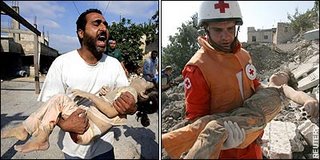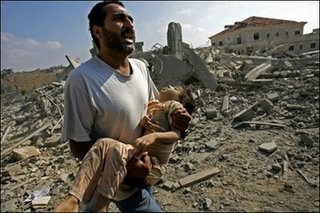It is the Jerusalem Post that makes the running this morning on the dismal conduct of the MSM, pointing out that, "Large sections of the international media are not only misreporting the current conflict in Lebanon. They are actively fanning the flames."
On the "fringe", as far as the MSM are concerned, are another two powerful pieces today (here and here) which demonstrate that the debate is by-passing the dead tree sellers, leaving them stranded in the quagmire of their own foetid mindset.
No better example of this mindset can be found than in the self-regarding Daily Telegraph "clog" (as in "corporate blog"), written by Shane Richmond.
In the first of a what he tells us is a three-part piece, under the group heading "disturbing images", he ponderously explains "the decision-making process behind using images of death and injury online and in the newspaper."
Already out of date with the casualty figures – Richmond still using the "54 civilians, 37 of them children" legend - the man gravely informs us that illustrating stories such as Qana "raises a dilemma". To what extent, he asks rhetorically, "is it acceptable to show dead bodies and how graphic can those photographs be?"
 In shedding "a little light on the process behind choosing an image", we are informed that the Telegraph tries "to avoid explicitly showing dead bodies…". The choice of picture depends on the story, what other images are available and - in some cases - consultation with the editor of the paper. "If the story merits it, or if the picture is the best image for the job, then we will sometimes publish a picture which may shock some readers," writes Richmond.
In shedding "a little light on the process behind choosing an image", we are informed that the Telegraph tries "to avoid explicitly showing dead bodies…". The choice of picture depends on the story, what other images are available and - in some cases - consultation with the editor of the paper. "If the story merits it, or if the picture is the best image for the job, then we will sometimes publish a picture which may shock some readers," writes Richmond.In the Qana incident, he continues, "the story was particularly powerful because so many of the victims were children. The most striking images of the day showed dead children and it was impossible to tell the story adequately without showing bodies."
Richmond then gets to the nub of the issue. There were "subtle distinctions to be made in the type of picture chosen". He asks us to compare two images (above left). One was used on the website (and on the front page of the paper). The other wasn't.
 The one not used was the uniformed Red Cross worker carrying a child's body. It is discarded because he is displaying no emotion. The other picture – no less than "White Tee-shirt" - "is reacting very emotionally to what is happening." So, proclaims Richmond, "not only does that make for a more powerful picture but it also takes some of our focus away from the body. Of course, there is no getting away from the fact that the man in this picture has a dead child in his arms. But that was vital to telling the story."
The one not used was the uniformed Red Cross worker carrying a child's body. It is discarded because he is displaying no emotion. The other picture – no less than "White Tee-shirt" - "is reacting very emotionally to what is happening." So, proclaims Richmond, "not only does that make for a more powerful picture but it also takes some of our focus away from the body. Of course, there is no getting away from the fact that the man in this picture has a dead child in his arms. But that was vital to telling the story." So, the mighty Telegraph reached out and published the "emotion" which was "vital to telling the story".
So, the mighty Telegraph reached out and published the "emotion" which was "vital to telling the story".But nowhere, so far, do we see Richmond ask the fundamental question – was the picture genuine? That, it seems, does not matter. As long as it is a "powerful picture" and it tells the story the paper wants to convey, that is good enough. Never mind that "White Tee-shirt", as our other pictures show, seems to be able to turn his emotions on and off at will. He served the Telegraph's purpose. Or did the Telegraph serve his?
* * * *
STOP PRESS
"26 rockets fired at North on Thursday" reports the The Jerusalem Post.
Tell me about it.
COMMENT THREAD
No comments:
Post a Comment
Note: only a member of this blog may post a comment.